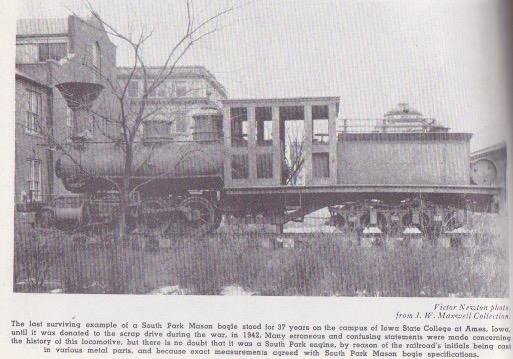The Last Mason Bogie-another look
The Last Mason Bogie-another look
|
We visited the Henry Ford Museum and Greenfield village again in October 2019 and caught a bit of footage of the Torch Lake, the last remaining Mason Bogie in the world. One of the docents explained that she was hidden (intentionally?) in the back of a shed behind other locos when taken out of service. This is what allowed her to avoid being scrapped (like DSP&P 57 was scrapped) for the wartime scrap drive during WWII.
Here is a post with the video of the Torch Lake leaving one of the stations. Enjoy, Kurt 
|
Re: The Last Mason Bogie-another look
|
The South Park Mason Bogies had very peculiar valve linkage over
the top of the boiler. What is the story with this engine ? Doesn't another Mason Bogie survive at Steamtown in the midwest ?
"Duty above all else except Honor"
|
Re: The Last Mason Bogie-another look
|
I did a quick Google search on for a Mason Bogie in Steamtown and nothing came up. Does anyone else know anything on that?
Here is the Henry Ford Museum's full info on their Mason Bogie: In November of 1969 a gift from the Universal Oil Products arrived at Greenfield Village. That gift was a locomotive once used by the Calumet & Hecla (C&H) Mining Company in Michigan’s Upper Peninsula. C&H Mining was a Boston, Mass.-based organization that was also a key player in Michigan’s Upper Peninsula copper mining. The Torch Lake, built in 1873 at the Mason Machine Works, Taunton, Mass. (factory #518), was initially used for switching and periodically on the C&H main line (until 1885); then exclusively as a switcher in the company yards. The Torch Lake is the last-known Mason-Fairlie locomotive in the world. The Mason Machine works had built more than 700 of these locomotives (mostly narrow gauge) that had a unique “bogie” system that allowed the wheel trucks to swivel under the locomotive when turning. This had the advantage of allowing the engine to make sharper turns-a distinct advantage when negotiating railroad tracks in the Upper Peninsulas “copper country.” The last time the Torch was fired-up by the Calumet & Hecla Mining Co. was in 1933. Being the last of their steam locomotives and after 50 years of service, it was decided to place the Torch Lake in indefinite storage. The locomotive had to be towed on the mainline part of its journey to storage due to it not having air brakes. When the main line portion of the trip was completed, it was left on a siding at Lake Linden. The boiler was fired up and it continued under its own power. As they crossed a bridge and main highway on the way to Ahmeek, Mich., engineer Edward Carter blew a long whistle thinking this would be the last steam train whistle heard in the Keweenaw Peninsula. It was placed in a storage shed at the C & H facility in Ahmeek, drained of water and left there untouched until 1966. That same year the Torch Lake was pulled out of the shed and towed to Calumet, Mich., to become part of the Calumet & Hecla Centennial. The train was cleaned, painted and put on display. After the Centennial, C & H offered the locomotive to the Edison Institute (now The Henry Ford) as a gift. The train was to be used for a new ride known as “The One-Way Railroad.” The Torch Lake arrived at Greenfield Village in November of 1970 (shown in the featured photo), but before it could be put in service at Greenfield Village the boiler had to be replaced as it could no longer pass state inspection. This kept the locomotive out of action for a year. During this time, the Johnston Brothers, Inc., of Ferrysburg, Mich., were contracted to replicate the boiler, firebox and steam dome. The new boiler was delivered in June of 1971, installed here, and the Torch Lake was converted from its original wood burning to being oil fired. On July 3, 1971, the Torch Lake was fired up for its maiden run at Greenfield Village. With a consist of three open passenger cars, the train would run along a half-mile track from Smiths Creek up to the duck pond behind the Ford Engine Engineering building (later known as the POEE building). To return, they backed the train to Smiths Creek where they would unload and load passengers. That first day the train carried 900 passengers. The three passenger cars were retired Soo Line oil tank cars that were rebuilt and converted to carrying passengers with decks and seating fabricated by Crown Metal Products in Wyano, Penn. Each car had seats for 70 passengers. The cars were covered with a curved metal roof and the sides were open to allow easy entrance and exit. Passengers got off and on the train from a raised wooden platform that was located by the Smiths Creek Station approximately where the current platform is located. Engineers for the Greenfield Village railroad were recruited from a list of retired railroad engineers provided by railroad companies. The first engineers were Frank Petrosky, formerly of the New York Central, and Ivan D. Meade, formerly of the Grand Trunk Western. The train operated from July 3 to Sept. 12, 1971 (67 days), and during that period provided steam train rides to 80,447 guests. The train ran from 11:00 a.m. to 5:30 p.m. and there was no set schedule. When they felt enough people were on the train they made the 12-minute trip. There is no information that indicates that the One-Way Railroad operated in 1972. In August of 1972 the One-Way railroad ride was replaced by a new 2.5 mile “Perimeter” railroad ride. |
«
Return to C&Sng Discussion Forum
|
1 view|%1 views
| Free forum by Nabble | Edit this page |

